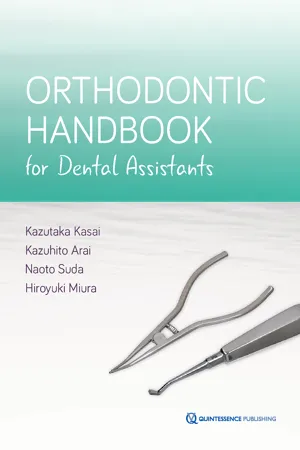![]()
•Understand the field of orthodontics.
•Understand the definition of orthodontic treatment.
•Understand the purpose of orthodontic treatment.
•Understand the definition of malocclusion.
•Understand the adverse effects of not managing malocclusion.
•Understand the role of the dental assistant in orthodontic treatment.
What is Orthodontics?
Most people are familiar with orthodontic treatment. A lot of information can be acquired online or in books; therefore, awareness of orthodontics is relatively high. The definition of orthodontics is “the treatment of irregularities in the teeth and jaws.” But how does the public perceive orthodontic treatment in modern society?
An awareness survey of teeth alignment and orthodontic treatment involving 1,000 men and women aged 10 to 50 years showed that most people think that tooth alignment determines one’s first impression and is therefore important for facial esthetics. The survey also showed, however, that people’s knowledge of the symptoms of tooth malalignment was quite low. Dental professionals should understand that orthodontic treatment is not only for facial esthetics.
The term malocclusion in orthodontics is defined as the misalignment of teeth or the incorrect relationship between maxillary teeth and mandibular teeth in intercuspation. Many variables cause malocclusion, classifying it as a syndrome. For example, simple malocclusion can be caused by oral habits such as mouth breathing or thumb sucking, whereas more severe malocclusion can be caused by congenital or acquired medical conditions, facial trauma, or severe periodontal disease (Fig 1-1). However, the condition can still be diagnosed as malocclusion regardless of the causes and symptoms. Irregular occlusion can occur at a variety of ages and with a variety of severities and states of oral function. Orthodontic treatment should be appropriate to the stage of physiologic and morphologic components of the condition, as well as the stage of the patient’s mental development.
Fig 1-1 Origins of malocclusion.
Orthodontics involves the study of dental growth and development, including research of dental arches and occlusal growth and development throughout a person’s life. It also involves the field of oral functional systems, including research of morphologic and functional improvement.
Orthodontics in modern society can be defined as follows:
Orthodontics is a dental specialty field that embraces research and study of the management of teeth malalignment and malocclusion. The purpose of orthodontics should be to provide healthy functional and esthetic dental arch and occlusion to patients to improve their quality of life.
The Purpose of Orthodontics
As previously stated, orthodontics is a specialty that treats patients’ malalignment and malocclusion in the dental arches. Malocclusion has several variables, and considerable complications may arise if it is left untreated (see Fig 1-2).
Fig 1-2 Representative malocclusion. (a) Crowding. As a result of an irregular tooth, the positional abnormality of individual teeth spans several teeth. (b) Maxillary overjet. The maxillary anterior teeth are markedly inclined to the labial. (c) Mandibular underbite. The maxillary and mandibular occlusion is reversed. (d) Crossover occlusion (crossbite). Maxillary and mandibular occlusions are laterally displaced. (e) Open bite. The anterior teeth are not in contact even in the occlusal position. (f) Overbite. The state of occlusion is so deep that the mandibular anterior teeth cannot be seen at the occlusal position.
The eight objectives of orthodontic treatment are as follows:
•Prevention of dental decay.
•Prevention of periodontal disease. If malocclusion is untreated, dental decay and periodontal disease may occur easily because of the difficulty of maintaining sufficient oral hygiene. Also, malocclusion makes dental decay management difficult for the dentist (Fig 1-2a).
•Prevention of oral trauma. Patients with maxillary protrusion have a high tendency to undergo maxillary anterior teeth trauma (fracture or avulsion) during sports (Fig 1-2b).
•Improvement of speech difficulties. Mandibular protrusion (Fig 1-2c) and open bite (Fig 1-2e) may cause speech difficulty with the following sounds: “s,” “z,” “p,” “b,” “m,” “w,” “t,” “d,” and “n.”
•Improvement of mandibular movement. Crossbite (Fig 1-2d) and overbite (Fig 1-2f) may cause unwanted posterior and lateral mandibular movement, which may in turn become precursors to a temporomandibular disorder.
•Improvement of breathing disorders. Patients who have abnormal craniofacial development, such as a retropositioned or small mandible, are known to have a high frequency of sleep apnea. Sleep apnea can also be found in children with large adenoids.
•Improvement of masticatory and swallowing dysfunction. Masticatory dysfunction frequently occurs in patients with mandibular protrusion because their maxillary and mandibular teeth cannot have normal contact during mastication. Tongue thrusting during swallowing is found frequently in patients with open bite.
•Improvement of facial esthetics. The patient’s attitude can be positively altered by improving his or her tooth alignment and facial esthetics. Although all objectives of orthodontic treatment are important, the patient will not be satisfied unless he or she is happy with the esthetic result.
Significance of Orthodontic Treatment
The World Health Organization (WHO) defines health as “a state of complete physical, mental and social well-being and not merely the absence of disease or infirmity.” Considering this definition, orthodontic treatment should contribute to a patient’s physical, mental, and social well-being and improve the patient’s quality of life by achieving all eight objectives of orthodontic treatment listed in the...



